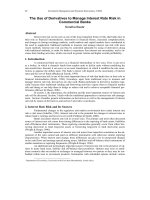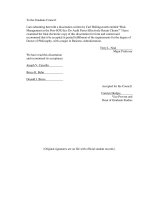Liquidity risk management in commercial banks
Bạn đang xem bản rút gọn của tài liệu. Xem và tải ngay bản đầy đủ của tài liệu tại đây (218.67 KB, 47 trang )
Liquidity risk management in commercial bank. Evidence from commercial
banks in Vietnam (2008-2015)
Abstract
In modern economy, the development of commercial banks plays an extremely important role in
the provision and transfer capital process. Commercial banks are always faced with variety of
risks. One of the most dangerous types of risk that could fast and widespread make the bank
insolvent, losing its reputation and even lead to the breakdown of the whole bank system is
liquidity risk. The issue of ensuring reasonable liquidity is considered as one of the most
essential tasks that must be respected in a regular, continuous and complete manner. This
dissertation will study general theory combining with investigating the current state of liquidity
risk management in Vietnam commercial banks in the period of 2008 - 2015. Then, researcher
would like to propose many solutions and recommendations in order to improve the effectiveness
of liquidity management in Vietnam's commercial banks in the coming time.
Key words: Liquidity, risks management, commercial bank, liquidity demand, liquidity supply
1
TABLE OF CONTENT
I.
INTRODUCTION
A bank that has ineffective activities for many years may lead to the risk of bankruptcy soon.
But there is no guarantee that a bank that which has profitable will have no risks.
Banks do business in a sensitive field which is called currency. Those issues belongs to the field
are always extremely considered because they could affect seriously on the development of
banks in particular and economy in general.
In fact, banks encountered many difficulties while ensuring safety and the highest profit rate at
the same time in their operating process. From the end of year 2007 and beginning of 2008,
liquidity problem became a hot issue in Vietnam society. The shortage of Vietnam dong in 2007
made banks raised interest rates simultaneously while Vietnam State Bank must issue a tighten
monetary policy to decrease inflation. It means that the shortage of liquidity or borrowing from
the interbank with high interest rates could affect to commercial banks in particular and the
economy in general.
Banks must prepare themselves the ability to manage liquidity under any circumstances in order
to invest money effectively, maximize profits as much as possible, reduce risks and avoid the risk
of bankruptcy. Hence, ensuring a reasonable level of liquidity is considered as one of the most
urgent tasks that must be respected in a regular, continuous and complete manner. In fact, there
are many studies in both theoretical and practical which investigating on liquidity risk
management with the aim of minimizing the risk to commercial banks. Since late 2002, the Basel
Committee has issued regulations regulating the bank's risk management including liquidity risk.
2
Along with it, the tools and methods of managing liquidity risk have been improved positively.
However, due to the limited practical conditions and limited experience, the application of
current international liquidity risk management standards to the operations of Vietnamese
commercial banks is not practical enough. It still needs to be added many criteria to reflect the
whole picture of liquidity of commercial banks in Vietnam. Hence, I chose the topic “Liquidity
risk management in commercial bank - Evidences from commercial banks in Vietnam
(2008-2015)" to study for my master's thesis.
I.1.
Statement of the Problem
This dissertation is conducted in order to answer those questions below:
a. Which principles apply to liquidity risk management?
b. What is the current practice of liquidity risk management in commercial banks in
Vietnam and how are their risk management structures?
c. What are the money market instruments of Vietnamese commercial banks available to
meet the liquidity needs of depositors?
d. What factors affect Vietnam commercial banks in managing liquidity assets and
liabilities, their liquidity management methods?
e. What are the liquidity risk mitigation measures?
I.2.
Research objectives
In this dissertation, researcher will focus on studying general theory of liquidity risk and
management combining with current state of liquidity management in Vietnam commercial
banks in many recent years.
Based on the survey information, the actual thesis, this dissertation has analyzed the liquidity risk
situation and liquidity risk management at many commercial banks in Vietnam. That could
reveal the causes of liquidity as well as factors affecting the liquidity management ability of
3
Vietnamese commercial banks. It is the basis for proposing solutions to prevent and limit
liquidity risk
Aim of research
- Clarify the theoretical issues of liquidity risk, methods of determining, measuring and
controlling liquidity risk; Tools to support liquidity risk management of commercial banks.
- Analysis and assessment of liquidity risk situation and liquidity risk management in Vietnamese
commercial banks; Indicates the causes of liquidity risk for Vietnamese commercial banks.
- Proposing measures to prevent and limit liquidity risk and improve liquidity management
capability at Vietnamese commercial banks in line with international practices.
I.3.
Scope and limitation of the Study
Due to the limitation of research time (2007 – 2014), this dissertation will rely on many general
theories as well as the annual reports of Vietnam commercial banks to investigate current
situation of liquidity risk and liquidity risk management in Vietnam. The limitation of this
research is only based on previous researches. Because of time limitation, so researcher cannot
collect data in a direct way. This dissertation is done in systematic from the problem formulation,
research purposes, data collection, and data processing
There is no data has been manipulated and the research is not responsible to the other calculation
based on another data that might be different by the other institution.
I.4.
Significance of the Study
The results of this research are expected to provide benefits for:
1. Academic
a. The author hopes this analysis can contribute to the next generation of University in particular
about proposing many useful methods to manage liquidity risk in commercial banks.
b. This research can be an example to research outside the University.
2. Bank Users
a. This research can be a reference to select the bank that can facilitate and provide good and secure
services for customers.
4
b. Provide convenience to determine which banks will be used to show maps based on the liquidity
risk management activities of commercial banks.
3. Bank
a. This study shows the picture of current state of liquidity in commercial banks as well as
proposing many solutions to manage liquidity risks which can be useful for banks to gain their
benefit stably.
b. The author hopes the study will provide a positive impact by giving a better idea to reduce the
bank’s weaknesses in managing liquidity risk.
4. The researcher:
a. This study is made to fulfil requirements to achieve a master’s degree
b. Make better understanding about liquidity definition and factors that affect to liquidity in
II.
commercials.
LITERATURE REVIEW
II.1.
Overview of liquidity at commercial banks
2.1.1. Commercial bank
Commercial bank is one of the most important financial institutions in the economy. It is
considered as the principal lender for millions of consumers such as individuals, households,
enterprises and most local government agencies. In a commodity economy, at a given time, there
is always exists the fact that there are people who are temporarily own some money that still
haven’t been invested, while there are people who need such amount of money (to meet
consumer demand or effective investments) and they can pay a fee to have the right to use this
money. According to the law of supply and demand, they will see each other and then all (the
lender, the borrower, and social) benefits both, production and circulation are developed and
improved life. Meet very diverse ways, and by the rise of commercial banks was born as a
necessity and an important way, the most popular. (Jesswein, Kurt R, 2006)
Through the bank, the money can easily get an income that needs money can get the money
needed at a reasonable cost.
5
It can be said that banks in particular and the banking and financial system in general are
occupying an important position and extremely sensitive in the economy, relating to the
operation of economic and social life.
More and more people are concerned to the activities of the bank, so what the bank is.
According to the bank statement published in 23-5-1990 of the State Council of Vietnam
identified: "Commercial Bank is a monetary business organization that operates primarily and
regularly receive deposits from customers with a responsibility in repaying that amount of money
and use those amount to lend, make the discount and as a method of payment.” (Morris, 2002)
Banking activities are considered as currency trading activities and banking services, with
regularly content is receiving deposits and using this amount to supply credit and payment
services.
2.1.2. Liquidity at commercial banks
2.1.2.1. Liquidity and the need for liquidity management
The basic function of the financial system is to provide liquidity. One of the important tasks of
bank managers is ensuring liquidity and maintaining liquidity at a reasonable level for the bank.
A bank is considered to have good liquidity if it can get the available funds at low cost at the
time the bank needs. It means that bank has good liquidity when it has certain amount of
available capital at a reasonable scale, or a bank can quickly raise funds through credit or sale
asset. Unreasonable liquidity is the first sign which clearly show that bank is in financial trouble.
Quantity of bank deposit is declined, reducing the money supply and forcing the bank to sell
liquid assets gradually. Other banks will not lend the problem bank without additional guarantees
or high interest rates. This will lead to the decrease in income and threatening to the existence of
banking institutions.
6
Many banks believe that liquidity can be borrowed at the right time. So they think that there is no
need to accumulate too much liquidity in the form of assets that easy to sell when needed at a
stable price. In fact, shortages have occurred in recent years, notably the insolvency that has led
to bankruptcy in many major US banks in 2008 which proves that liquidity security is a
requirement that cannot be overlooked.
Liquidity management is therefore more important than ever because the bank may be closed if it
fails to mobilize sufficient liquidity. In 1997, because of the financial crisis, many banks in Asia
lose billions of dollars, panic customers, insolvent banks, bankruptcy or forced mergers. US
financial sector in 2008 combining with the collapse of big banks has indicated the importance of
ensuring liquidity in the bank. Hence, the commercial banks should focus on liquidity
management and raising high liquidity efficiency as a daily issue because it relates to the
existence and development of each bank and the whole system.
2.1.2.2. Liquidity at commercial banks
Liquidity of assets: A bank manager is always concerned about the liquidity of each asset and
the asset portfolio. The liquidity of each asset is the ability to convert assets into cash which is
measured by time and cost. The higher the time and cost of asset liquidity, the more likely it is to
reflect the risk (loss) of converting assets into money over a specified period of time. For a quick
sale, the cost (or loss) is large. This shows that the liquidity of an asset depends on many factors
and may change depending on each regions and countries.
Banks hold asset portfolios with various kind of liquidity. Asset structure with different liquidity
characteristics creates a group of assets or total assets of liquidity. Liquidity of portfolio assets is
measured by the ratio of highly liquid assets to total assets (or on customer deposits at banks)
7
Liquidity Source: The bank mobilizes capital to create assets, including highly liquid assets.
Thus, the ability to mobilize contributes to payment ability of banks. The liquidity of the source
is measured by time and cost which is used to expand the source. The lower the time and the cost
are, the greater the liquidity of the source. Actually, the liquidity of the source depends on many
factors such as the distribution development of the financial market, the increase in the income of
the population and the sensitivity of the income to the interest.
Liquidity of a bank: The liquidity of a bank is the ability that bank can meet customer’s needs.
It is formed by the liquidity of the assets and the liquidity of the source. It will be highly liquid
when there are many liquid assets or are able to expand quickly with low cost or both, in line
with liquidity needs.
Supply and Demand:
Liquidity supply is the ability of a commercial bank to provide money to meet customer’s needs,
(liquid assets holding and mobilize ability). Liquidity supply in bank includes: deposits from
customers, sales of non-deposit services, repayment of customers' loans, loans from the monetary
market.
Liquidity demand is the payment demand of the bank's customer that the bank is obliged to meet.
Liquidity includes legal claims and borrowing requirements of the client. Liquidity needs of the
bank include: Cash withdrawal from accounts, requests for loans from high quality credit
institutions, repayment of non-deposit loans. Cash and tax expenses appear in the production and
service process, payment of cash dividends.
Liquidity risk: Liquidity risk is the loss that occurs when actual liquidity needs exceed the
expected liquidity. At that level, bank must increase the costs to meet liquidity demand which
8
could lead to the decrease in bank's net income, at a higher level than the loss of liquidity that
will lead to bankruptcy.
Liquidity Management
II.2.
II.2.1.
Liquidity management objectives and rules
II.2.1.1.
Defining liquidity management objectives
Liquidity is directly related to the safety and profitability of the bank. Therefore, maintaining
liquidity is an important objective throughout the bank's operations. In order to increase liquidity,
costs must also increase and this can reduce the bank's income. For example, if the bank holds
more funds or liquidity increases, the bank's earnings will decline as a result of low, even profitmaking funds such as cash in the bank. In contrast, if the bank holds too little money, banks have
to raise funds in case of emergency, which makes interest payments are higher than usual. This
can lead to the decrease in bank’s earnings. Therefore, the bank's liquidity management
objectives include:
-
Ensure timely payment of bank at reasonable cost
-
Predict liquidity risk and loss
Rules of liquidity management
II.2.1.2.
Firstly, the liquidity manager must carefully observe activities of departments which relate to the
mobilization activities or use of funds in bank and must coordinate the operations of the liquidity
management department with those departments. When the credit bureau issues a new credit line
to client, the liquidation manager must prepare for the ability to withdraw funds from this credit
limit. Or if deposit department expect to sell large deposit certificates in the next few days, this
information must be immediately submitted to the liquidity management office.
9
Second, the liquidator needs to know when and where the largest borrowers and the largest
depositors will withdraw funds or deposit more money. This allows managers to better deal with
the occurrence of deficits and liquidity surplus.
Third, liquidity managers need to coordinate with senior manager to ensure that the objectives
and priorities for the liquidity problem are clear. In recent years, the state of liquidity is always a
top priority in the process of allocating funds. It is clearly that the bank cannot manage the funds
(mainly deposits) because amount of deposit money entirely depend on the public. However, the
bank can manage the use of capital. In addition, the bank must maintain a required reserve ratio
at the central bank to meet its liquidity needs. Bank must always be ready for withdrawal
requirements, so manage liquidity and invest a reasonable portion of capital into liquid assets at
all times are always top priority. Today, liquidity management plays an important supporting role
in the bank's core activities such as lending and providing other fee-based services. Bank can
make profitable loans and the liquidity management office will be responsible for finding
financing.
Besides, liquidity needs must be constantly researched to avoid a surplus or liquidity shortage.
Liquidity surplus means if bank does not invest additional capital, bank’s income will be
reduced. At the same time, liquidity shortages forced banks to respond quickly to avoid selling
assets or capital to meet liquidity needs.
Content of Liquidity Management
II.2.2.
Liquidity demand
II.2.2.1.
a.
Liquidity demand is the demand for available capital which primarily arises from two main
sources: the demand for withdrawals and demand for loans from customers. In addition, loans
from other banks or central banks also increase liquidity demand.
10
Specifically, liquidity demand includes:
- Liquidity arising on the property side:
•
Required reserves
•
Demand for quality customer credit
- Liquidity arising from capital sources:
•
Customers withdraw money
•
Release of valuable paper
•
Debt repayment
Liquidity is off balance sheet
•
Payment of operating expenses, tax payment
+ Payment of dividends
b.
Factors affect liquidity
First, the group of factors creates panic in depositors such as political instability, corruption.
Second, the group of factors related to income and expenditure of customers such as income
level, population density and business.
Third, the group of competitive factors in financial intermediaries such as deposit interest rate
policy, credit policy of each organization.
Fourth, groups of factors create the strength and prestige of the bank, such as officials,
technology, market share, prestige etc.
c.
Liquidity demand management method
•
Bank will analyze liquidity needs in the past
•
Measure the relationship between the influence factors and liquidity needs to determine
the frequency and magnitude of liquidity needs.
11
•
Analyze and quantify liquidity demand for each type of deposit, each group of customers
and each period of the year.
After analyzing the factors affecting the liquidity needs, the manager will identify the liquidity
management strategy by establishing a policy of conditions to stabilize liquidity needs. Based on
this, ensure liquidity is ensured and income is maximized.
Liquidity Supply
II.2.2.2.
Liquidity supply arising from assets includes:
•
Budget
•
Customers refund credit
•
Deferred payment from investment in securities
•
Income from selling property
Liquidity arising from capital sources includes
•
New deposit of customer
•
Borrowing in the money market
•
Release of valuable papers
Management of liquidity supply from asset-reserve strategies:
Banks must maintain the ability to meet the needs of demand payment of customers. Liquidity
supply can be created from 2 criteria: maintain reserve and ability to mobilize
.
According to the internal control, it can meet the needs of payment of assets through strategic
reserves. This means that the retention of assets through asset management can provide liquidity.
On the risk side, this means that the bank needs to create a suitable asset in terms of time,
volume and structure of the source.
Budget Analysis:
12
A bank usually meets the needs of customers by cash: cash in safes, deposits at the State Bank
and other credit institutions. If a customer has a savings deposit at a bank, bank will issue a cash
fund to pay simply. If a customer has a balance on his / her deposit account, signing a check or
money order to pay to a customer at another bank, the bank will use the deposit at the State Bank
or the deposit at the institution credit to pay…If a customer wants to be paid but he/she has no
enough money yet then the bank can lend (after the credit analysis) customers to pay. Loans can
be in form of cash or transfer ... loans that are due (loans from the State Bank or the issuance of
bonds, banks pay in cash or transfer ... these activities are made with the aim of helping
customers make timely payment and investment activities.
Factors that increase the decrease in budget and treasury policy: the budget (a part of the bank's
reserves) includes the bank's most liquid assets, which are regularly replenished from the
increased cash inflows. Deposits, borrowings, debt collection, securities held by banks, etc. are
also used frequently to pay deposits, loans, investments. Increased or decreased funds may be
due to objective factors such as seasonality, business cycle and customer income, changes in
management regulations, or system ... or by the bank. According to the reserve strategy which is
pursued by bank, increasing the budget (as other conditions do not change) will reduce the bank's
income. Thus minimizing the budget (minimizing idle money) is the goal that banks must
pursue.
Other reserves outside the budget
Bank executives are always looking for assets that can replace liquidity, while increasing the
bank's profitability. As the government bond market develops and the government's
commitments become more robust, government bonds become less risky and highly convertible
assets (nearly treasury) and yields higher than the budget. This type of asset is classified as a
13
buffer between funds and credit.Other credit and securities items also have different liquidity.
Discounts can be rediscounted at low cost, high-quality loans are out of date, or easy to sell, and
many short-term credits do increase the liquid properties.
Estimates of supply liquidity from assets
In order to respond effectively and promptly to the needs of customers, the bank needs to
maintain appropriate liquidity assets as the liquid assets only bring about a lucrative profit. Asset
liquidity to meet essential needs such as compulsory reserves, daily payments to depositors.
Banks also have to hold liquid assets to "reserve" in cases of sudden changes in demand
withdrawn from the bank. And in the third case, liquid assets are maintained for the purpose of
"attacking" - lending in case of necessity.
The liquidity of assets is changed frequently: when the real estate market is vibrant, real estate is
highly liquid and vice versa. When the SBV loosens monetary policy, the negotiable instrument
can easily be discounted and vice versa. Banks in different regions or countries, the liquidity of
assets is different. Then analyzing and quantifying the liquidity of each asset is essential.
The liquidity ratio needs to be maintained
Primary reserve / Total assets
(Primary reserves + secondary reserves) / Total assets
(Fund + liquidity securities) / Short-term deposits and loans
Primary Reserve / Credit
Banks should consider the appropriateness of each rate, selecting appropriate levels for each
period. Banks also need to determine the total liquid assets to be held through liquidity needs
analysis. The maturity date of the assets held together with the funds must meet legal reserve
requirements (compulsory reserve) and demand for payment (liquid demand).
14
Reserve strategy and profitability
The bank's reserve strategy - maintaining liquidity and other liquidity assets - must always weigh
between liquidity and profitability. The bank has to weigh the income that it has to give up in the
present to maintain liquidity with possible future expenses to buy liquidity. This consideration
should be based on the analysis and quantification of liquidity needs and the ability to provide
current and future liquidity through liquidity of assets.
Management of liquidity supply from capital sources or mobilization strategy:
With the development of the debt instruments market, banks can develop their mobilization to
meet their liquidity needs.
Analysis of factors affecting time and cost of mobilization
Methods to meet the demand for liquidity from the source party depend heavily on the cost and
time of mobilization, ie, depending on the development of the source market. A number of
factors, from macroeconomic stabilization policy of the central bank and government, the
development and competition of banks and other financial intermediaries in the country, region
and the world, the sensitivity The impact of the deposit on interest rates, banking networks, etc.,
impacts a bank's ability to rapidly expand at a low cost.
15
In general, banks set up a policy to mobilize and use cash flows to meet their expected credit and
investment while maintaining liquidity at the required level. The difficulty is the
inappropriateness of the size and maturity of cash inflows to the needs of the bank. Turning the
maturity of cash inflows and outflows - that is, creating a maturity of depositors and borrowers is an important part of commercial banks' operations. Banks may also be exposed to interest rate
risk and liquidity risk. Due to the maturity of the source and assets then bank will consider the
holding of more liquid assets.
Select the liquidity supply from the source
Central bank loans are often used to meet liquidity needs as interest rates are usually the lowest
in the lending interest rate bracket. The interbank market rate is usually just higher than the
central bank's interest rate, with simple borrowing procedures, largely based on the bank's
reputation. For banks that are temporarily excess reserves, lending will bring higher returns.
Borrow by issuing short-term notes such as certificates of deposit. The interest rates of these
debentures are usually higher than the term savings deposits but have a relatively fast
mobilization period. This type of paper usually focuses on businesses and high-income residents.
To increase the attractiveness of debt paper, many banks have sought to re-establish the market
for debt securities. Banks can raise deposit rates to compete with other banks to mobilize more.
This method is applied when the bank needs capital at a high cost. Many banks use methods to
expand and diversify their depositors such as opening branches in different regions, different
countries, offering a variety of deposits and services, increasing utility for people. This is a
strategy that meets the liquidity needs of the source structure itself.
II.2.2.3.
Combined management
16
The combined liquidity management strategy has become popular, based on maintaining
liquidity of both assets and capital. In general, large banks which close to the monetary center;
tend to rely primarily on the liquidity of the source party while smaller banks, far from the
monetary center, tend to maintain liquidity based on liquidity assets.
Moreover, most banks have made a compromise in their liquidity management policy, using both
liquid asset management and debt liquidity management to avoid many risks. According to the
combined management strategy, part of the expected liquidity needs will be fulfilled by stock
liquid assets (mainly securities and deposits at other banks) while the rest of liquidity needs will
be addressed by credit line agreements from correspondent banks or other lenders. Cash
requirements will be solved mainly by borrowing. The bank needs to plan for the demand for
long-term loans and capital used to meet this requirement. It could be in form of short-term,
long-term loans and securities, the assets will be converted into cash when liquidity requirements
appear.
Liquidity Risk Measurement and Monitoring
II.2.2.4.
Liquidity risk management is such an important and necessary issue to any banks. In order to
effectively manage liquidity risk, banks need to set up an effective monitoring and measurement
system. That measurement system will help banks to anticipate liquidity risks and take
preventive measures in time to avoid the serious damage.
Each bank has a different relation with their liquidity risk because liquidity scale also depends on
size and many different criteria such as: complexity of bank...then each bank will seek suitable
measurement techniques to manage liquidity risk. For example: large banks often have large and
stable deposits, while smaller banks often rely on deposits from large institutions. In fact, even
with abundant liquidity, banks still need the support of liquidity measurement and monitoring
17
tools to manage liquidity in crisis time and optimize return on their current funds. There are
many liquidity measurement and monitoring techniques which are commonly used by banks,
such as: Contingency Funding Plans, Cash Flow Projections, Liquidity Ratios and Limits,
Internal Controls and Liquidity risks. Those techniques will be analyzed specifically.
Contingency Funding Plans: In order to develop an efficient and comprehensive liquidity
management model, banking institutions need to come up with different scenarios. Contingency
Funding Plan (CFP) contains many policies and procedures which could help bank to meet its
funding needs in a managing liquidity risk at a reasonable cost. CFP is used to predict future cash
flows and other bank financial resources. CFP should represent an estimate of balance sheet that
may result from a liquidity or credit event to increase effectiveness. CFP can provide an effective
short term and long term liquidity risk management model. Besides, it also helps the financial
institution to update the movements of liquidity regularly.
Cash Flow Projections:
Banks often use cash flow measurement to determine their cash position. Cash flow can estimate
bank cash inflows and outflows, thus projecting a deficit and net surplus (GAP) over time.
Banks need to distinguish clearly between the re-pricing gap report that measures interest rate
risk and a behavioral gap report which takes into funding requirement of banks arising out of
distinct sources on different time frames. In order to compare cash inflows and outflows on a day
or specified period of time, bank need to construct a maturity ladder. Banks, which rely on shortterm funding, will primarily focus on managing liquidity on very short term while other banks
might actively manage their net funding requirement over a longer period. Cash flow projection
could estimate accurately bank’s flow of funds in short- term. Those estimates will play
important role as an indication of actions. Moreover, bank will have opportunity to well - control
18
GAP with an analysis for distant periods. Consequently, it is better for banks to apply short time
frames to measure near term exposures and longer time frames thereafter. Banks should calculate
daily GAP for next one or two weeks, monthly Gap for next six month or a year and quarterly
thereafter. Those aspects below should be attention when making an estimation of cash flow.
a) The funding requirement arising out of off- Balance sheet commitments also need to be
accounted for.
b) Many cash flows associated with various products are influenced by interest rates or customer
behavior. Banks need to take into account behavioral aspects instead of contractual maturity. In
this respect past experiences could give important guidance to make any assumption.
c) Some cash flows may be seasonal or cyclical.
d) Management should also consider increases or decreases in liquidity that typically occur
during various phases of an economic cycle.
Liquidity Ratios and Limits:
Using ratios to determine liquidity is a method commonly used by banks. The ratio used to
quantify the liquidity is also varied. Besides measuring liquidity, it also determines the limits for
liquidity management. However, ratios will be most useful when being used regularly and
interpreted taking into account qualitative factors.
In order to accurately forecast liquidity, the bank needs to combine the analysis of information
relating to borrowing capacity, ability to request early withdrawal, credit line, transaction size.
It could be said that financial ratios is the foundation of asset-liability management decisions, a
bank's asset-liability managers should understand how a ratio is constructed, the range of
alternative information that can be placed in the numerator or denominator, and the scope of
conclusions that can be drawn from ratios. Because ratio components as calculated by banks are
19
sometimes contradictory, ratio-based comparisons of institutions or even comparisons of periods
at a single institution can be deceptive.
•
Cash Flow Ratios and Limits
The failure of the bank to fulfill its payment obligations is considered as one of the most serious
risks to liquidity. Thus, cash flow ratios and limits attempt plays has a duty to measure and
control the volume of liabilities incurring during a specified period of time.
•
Liability Concentration Ratios and Limits
In order to preventing bank from depending on many providers or funding sources, liability
concentration ratios and limits are decided to apply.
•
Other Balance Sheet Ratios
There are many common ratios which are used by financial institutions to monitor current and
potential funding levels such as: total loans/total deposits, total loans/total equity capital,
borrowed funds/total assets etc.
Accounting estimates and Liquidity ratios:
In addition to the provisions on cash reserves, banks also need to set limits on the level of
liquidity risk within acceptable limits. Limits should be reviewed and adjusted periodically.
Besides, senior management of bank should analyze the strategies and activities of banks, what
bank have performed, earnings level, available fund to face potential losses, and acceptable risk.
Balance sheet will reveal a level limitation that a bank should establish to manage liquidity
effectively. In case limits cannot prevent a liquidity crisis, limit exceptions may be use as an
indicator to excess risk or inadequate liquidity risk management. However, most of the banks
estimate liquidity based on the ratios on a specific date. There are two types of liquidity
indicators:
20
a) Asset based or Stored Liquidity Ratios, b) Liability based or Purchased Liquidity Ratios.
a) Asset based or Stored Liquidity Ratios:
1) Cash position indicators = Cash + Deposits
Total Assets
2) Liquid Securities Indicators = Govt. Securities
Total Securities
3) Risk less Assets Position = Cash+ Deposits+ Govt. Securities
Total Assets
4) Net Treasury Funds Position = Balance of Reserves with Central Bank
Total Assets
5) Liquidity Assets Ratio = Cash+ Reserves+ Govt. Securities
Total Assets
6) Capacity Ratio = Net Loan + Lease or Rent
Total Assets
7) Pledged Securities Ratio =
Pledged Securities
Total Securities Holdings
b) Liability based or Purchased Liquidity Ratios:
1) Hot Money deposit = Withdraw able Hot Money Deposits
Total Hot Money Deposits
2) Short- term Deposit to Assets= Short- term Deposits
Total Assets
3) Short- time Investments to Sensitive Liabilities = Short- time Investments
Sensitive Liabilities
21
4) Deposits Brokerage Index = Brokerage deposits
Total Assets
5) Core Deposits Ratio = Core Deposits
Total Assets
6) Deposits Composition Ratio = Current Deposits
Term Deposits
7) Transaction Deposits Ratio = Transaction Deposits
Non- transaction able Deposits
Internal Controls and Liquidity risks: If banks want to implement the policies as well as
procedure effectively, they must daily examine the process and various procedures. In fact, the
bigger and more complex the bank, the more they should do the examination. Reviewers should
verify the level of liquidity risk and management’s compliance with limits and operating
procedures. Any exception to that should be reported immediately to senior management / board
and necessary actions should be taken. Senior management must update the current risk
management situation of the bank by receiving regular reports. That will help senior predict the
level and trend of the bank’s liquidity risk and figure out how much liquidity risk the bank is
assuming.
Convertibility of asset
Based on the analysis of the number of bankruptcies in the UK and US in the financial crisis of
29-33, the authors of the theory argue that the number of British banks (mainly commercial
loans) goes bankrupt were approximately with US banks (extending loans to real estate and
consumers). So, commercial loans also do not ensure liquidity safety for commercial banks when
22
the crisis occurs. It is clear that the main problem for ensuring liquidity is the ability to generate
income of banks (increase their accumulation capacity) and the ability to convert assets. With the
development of the stock market, banks can have the necessary revenue when they meet the
liquidity needs. Thus, banks can completely make non-commercial loans while still ensuring the
liquidity of banks.
II.2.3.
Expected income theory
This theory assumes that asset receipts not only occur when assets are due but also over time
throughout the life of the asset. For example, if the bank provides medium and long term loans,
debt collection under multiple debt terms is expected to increase the liquidity of assets.
This theory is an important foundation in the study of maturity of assets and capital, which is the
main content to manage asset's liquidity. Build debt recovery plan. Expected earning of the asset
is a measure of the liquidity of the asset.
II.2.4.
Debt Management
This theory was formed in the mid-1960s associated with the formation of new mobilization
tools such as Certificates of Deposits (CDs) and the CD market that allowed large banks in precash centers. It is a bad thing to be able to mobilize a large amount of capital at a cheaper cost
than the issuance of medium and long term bonds.
Along with the development of the interbank market, banks are able to lend to each other on a
large scale, with low transaction costs. This activity enhances the ability of commercial banks to
borrow. A bank with high creditworthiness (fast time, large scale, low cost) is highly liquid.
In short, bank managers can maintain a portfolio of assets that is more profitable than liquidity
and use new mobilization as the primary means to meet liquidity needs.
III.
RESEARCH METHODOLOGY
23
3.1. Research Method
According to (Sugiyono, Metode Penelitian Bisnis, 2007) research method can be defined into
two main groups, which are quantitative and qualitative research method.
1. Quantitative research method is a method of research that is based on the philosophy of
positivism, used to examine the population or a particular sample, the sampling technique
is generally carried out at random, using a data collection instrument of research, data
analysis is statistical in order to test hypotheses that have been determined.
2. Qualitative research method is a method of research based on the philosophy of research
is used to examine the condition of the natural objects, where the researcher is a key
instrument, sampling conducted by purposive data sources and snowball, collecting
technique by triangulation (combined), inductive data analysis, and qualitative research
results further emphasize the significance than generalization.
This research will be conducted as a quantitative research approach which involves analysis
of numerical data in an attempt to explain the matters observed. The numerical data then will use
to prove or disprove a significant hypothesis. The advantage of using quantitative method for the
researcher is it is more controllable and more reliable to test the correlation between variables.
3.2. Method of data collections
There are two different categories for data collection, which are Primary data and Secondary
data (Kothari, 2004). Primary data are those which are collected afresh and for the first time, and
thus happen to be original in character. The secondary data, on the other hand, are those which
have already been collected by someone else and which have already been passed through the
statistical process.
24
In this research, secondary data will be used to analyze. Secondary data can be made faster
and easier than with the primary data collection. Data collection method is techniques that can be
used by researcher to collect data. Further, the method of data collection depends on research
methodology, whether is quantitative or qualitative. The collecting data for this research should
be systematic because if it is not systematic, it will be difficult for the writer to accomplish this
research (Lind, Marchal & Wathen, 2012). In term of data collection, the researcher use will
collect data from a number of prominent commercial banks in Vietnam from 2008 to 2015
through a series of financial statements and balance sheets. The report will then use the following
methods to analyze the liquidity risk management situation at Vietnamese commercial banks.
IV.
EVALUATION
IV.1. Current
situation of liquidity management in Vietnam commercial banks
IV.1.1. System of Vietnam commercial banks
Vietnam's banking system differs in two stages:
Banks in the planning mechanism:
The first credit institution of the Democratic Republic of Vietnam was the Credit House which
was established in 1991. This is the precursor of the State Bank of Vietnam. State Bank of
Vietnam with the system of provincial and district branches were former credit institutions with
function of mobilizing deposits of businesses, mass organizations, economic organizations and
residents to lend. It played a role as a monetary authority and a nonprofit business organization.
The State Bank played an important role in war against French and American or building
socialism as well as building country. After 1975, socialist countries encountered with so many
difficulties, aid to Vietnam is declining. Vietnam faces a number of major challenges: famine,
urgent social issues, devastated buildings, factories, extremely lack of foreign currency to import
25









